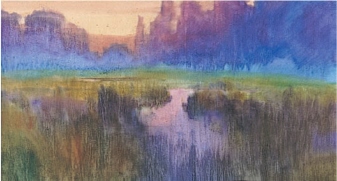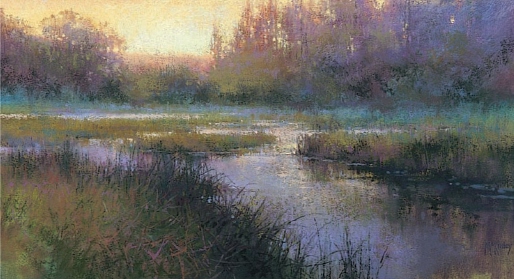
underpainting with an oil stain
Richard McKinley likes to begin his pastel paintings with oil stain underpaintings. He applies the oil stain either to a surface coated with gesso, acrylic and pumice, or to Wallis Sanded Pastel Paper (raw paper would deteriorate quickly with this application). To avoid filling the tooth of his surface, he generously thins the oil paint with odorless mineral spirits. The goal is to create an oil stain or wash, not an oil painting.
The surface should be allowed to dry before you add pastel; either place it in direct sunlight for a little while or let it dry overnight.

start by staining
An oil paint stain on a gesso/pumice prepared surface.
you don’t always need an underpainting
While underpaintings are one way to begin a pastel painting, they are not a requirement. You can pick up a piece of paper and begin immediately with pastel. How do you know when to underpaint and when not to? There are no absolute rules, but in general an under-painting is not a good idea if you’re working on a surface with very little tooth, such as Canson paper. On surfaces with little tooth, you’ll need to limit the number of layers you apply; most untreated surfaces cannot be washed with a liquid.
If you’re working on a surface that already has a color, such as Art Spectrum’s Colourfix, you may not want to apply an underpainting. You’ve selected that color because it will complement or harmonize with the colors you’re going to apply to it, so an underpainting isn’t necessary.
Experiment with underpaintings when you’re working on a surface that can take a number of layers, and see if you like any of these methods. Remember that not all methods work for every artist, and that the only right way to paint is the way that works for you.

My Evening Place
13" × 24" (33cm × 61cm) by Richard McKinley
the finished product
The basic color pattern is established with the oil stain, setting the tone and mood for the layers of pastel to follow. Note how some colors are modified to lighter values, such as the sky and the hint of the setting sun, while others are darkened slightly, such as in the foreground water.